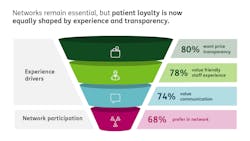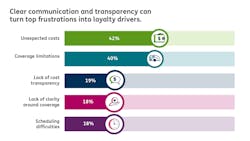In Network or Out? Rethinking the Role of Networks in Patient Loyalty and Access
Key Highlights
- Nearly seven in ten decision makers still prefer in-network providers.
- Forty-two percent of dental decision makers cite unexpected costs as their top dental frustration.
- Eighty percent of dental decision makers want price transparency for procedures.
- Only sixty-nine percent believe fluoride prevents tooth decay, a key education gap.
The following article is a paid editorial for the October 2025 Dental Economics magazine and is authored by Michelle Hart, AVP, Dental Networks for Humana.
The evolving role of insurance networks
For decades, participation in insurance networks has been the cornerstone of patient acquisition and retention for dental practices. Networks offer predictability, affordability, and access, the foundation on which many practices have built their patient bases. But today, those networks exist in a more complex environment. Patients have more choices, and they have greater access to information, as well as higher expectations for convenience and clarity.
As a result, being “in network” is no longer enough on its own. Practices must meet patients where they are, combining the financial advantages of network participation with a more transparent, patient-centered experience that reinforces loyalty.
Why networks still matter
Even in this shifting landscape, networks remain an anchor for many patients. Insurance participation delivers a sense of trust and predictability that patients value, particularly when they are focused on affordability. According to a recent Humana survey, nearly seven in ten decision makers still say they prefer in-network providers, showing that coverage remains an essential factor in their dental care decisions.1
For practices, the value of being in network extends beyond patient preference. Network participation remains valuable because it provides patients with affordability, predictability and access to the covered services they need. It also helps build long-term continuity of care that keeps patients connected to providers who know their history and needs.
Changing patient behaviors
While networks remain influential, they are no longer the sole driver of loyalty. Patients, especially younger adults, are increasingly willing to go out of network if it means greater convenience, shorter wait times, or access to specific treatments. Network status is now just one part of a broader loyalty equation.
Loyalty is not guaranteed by coverage alone. If your practice relies solely on network participation, it risks losing patients to competitors who are more responsive, transparent and convenient.
What patients want beyond coverage
So, what do patients expect in addition to network participation? Three themes stand out:
-
Transparency of pricing and coverage – Patients want to know what to expect before treatment begins. Unclear or unexpected costs remain the number one source of frustration, cited by 42% of respondents, while nearly one in five (19%) said the lack of cost transparency was itself a top pain point.1
-
Ease of communication – Patients increasingly expect seamless communication with both their dentist and their insurance provider. In fact, 74% of decision makers said that being able to easily contact and communicate with their insurance provider is important to their dental health experience.1
-
A positive experience from start to finish – Patients notice details, from the friendliness of front desk staff to the cleanliness of the waiting room. The survey found that 78% of patients rate friendly, knowledgeable staff as important, and 73% emphasized the value of appointment reminders and availability.1 These “human touches” are powerful drivers of loyalty.
Practical steps for dental practices
For dentists and office managers, the path forward goes beyond choosing between network participation and patient experience. Providers must consider leveraging both together to create a stronger value proposition for the patient.
Here are five practical steps practices can take:
-
Proactively communicate the value of in-network care – Don’t assume patients understand what “in network” means for their wallet. Explain the savings, reduced paperwork, and smoother coordination that come with in-network care. Position yourself and your practice as a provider and as a partner that helps patients maximize their benefits.
-
Make transparency a non-negotiable standard – Before any procedure, provide a clear, itemized estimate that reflects insurance coverage and anticipated out-of-pocket costs. They may not always like the numbers, but patients will appreciate knowing them in advance. Plus, it reduces the frustration that erodes loyalty.
-
Invest in staff training and patient experience – Friendly, knowledgeable staff are consistently ranked among the most important elements of the dental experience. Training your team to communicate clearly, show empathy, and follow up with patients proactively can be just as important as clinical expertise when it comes to retaining patients.
-
Adapt to generational differences – Younger patients, particularly millennials and Gen Z, value convenience and flexibility. Practices that offer online scheduling, evening appointments, or even telehealth consultations for initial assessments are more likely to capture their loyalty, even if coverage options are more limited.
-
Connect oral health to overall health – Most patients understand that oral health is linked to chronic conditions like diabetes and heart disease, but gaps remain. While 80% of respondents recognize that oral health impacts chronic conditions, and a similar share link it to overall health, only 69% believe fluoride has been proven to prevent tooth decay.1 These gaps highlight the opportunity for dentists to educate patients on the preventive benefits of regular care and reinforce the value of in-network preventive services to support overall health.
Looking ahead: the role of innovation
Emerging tools like artificial intelligence (AI) are beginning to shape patient expectations, particularly around cost transparency and diagnostics. While many patients remain cautious about AI confirming diagnoses, a growing share is comfortable with AI-generated cost estimates.
The takeaway here is that practices shouldn’t rush into technology adoption just for the sake of technology adoption. Patients are open to innovations that make their experiences clearer and more predictable. Practices can capitalize on that fact by blending innovation with human-centered care to gain a competitive edge.
The path forward
Insurance networks remain essential, but they are no longer the sole driver of patient loyalty. Today’s patients want more. They want clear costs, convenient communication, and experiences that make them feel valued.
For dental practices, the opportunity lies in combining the strengths of in-network participation with a patient-first mindset. By proactively communicating value, investing in transparency, and elevating the patient experience, practices can retain loyal patients, strengthen clinical outcomes, and thrive in an increasingly competitive marketplace.
Networks are still the backbone of dental care, but the practices that succeed will be the ones that build on that backbone with clarity, compassion and connection.


